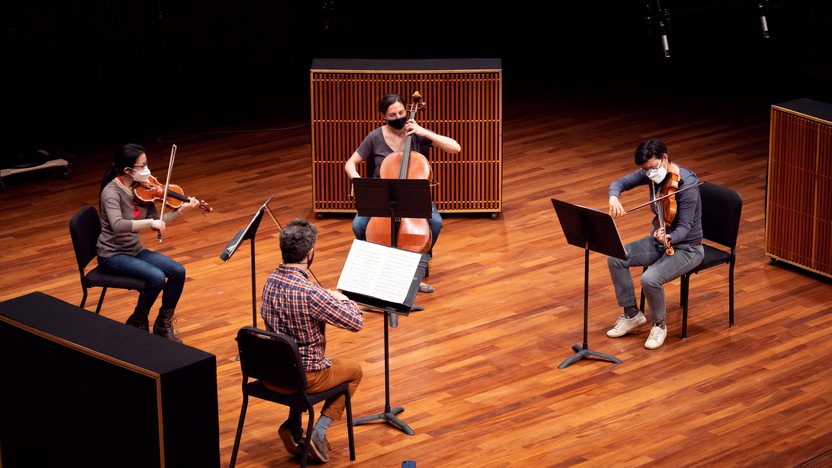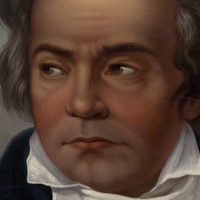EXPRESS CONCERT: Beethoven, Coleman and Tate



Jerod Impichchaachaaha' Tate, a member of the Chickasaw nation in Oklahoma, creates classical compositions rooted in Indigenous traditions. Drawing on the techniques he honed at Northwestern University and the Cleveland Institute of Music, Tate has garnered many awards and commissions for his chamber music, orchestral works, film scores and even a grand opera.
In a video recorded for the New York Philharmonic (which commissioned and premiered an orchestrated version of Pisachi earlier this year), Tate spoke to how he draws on his Chickasaw heritage. “What we all do as artists,” he explained, “is we take our own experience, we take our environments, we take our histories, and we break down the elements that we know, and we abstract them inside of us and reconstitute them. … And so I am hearing all of our ancient melodies, I’m imagining our dances, and I’m thinking about the different phrasing and all the meters that go with that, and the different scales that we have, and melodic structures. I take all of that inside and I deconstruct our ancient music and then I reconstruct it in an abstract form.”
Tate originally wrote Pisachi (the Chickasaw word for “reveal”) in 2013 for the string quartet ETHEL, and he described it in a program note as “an homage to the American Indian Southwest. In my early teaching career,” he wrote, “I was blessed to mentor Diné and Hopi youth, and the spirit of Pisachi is nested in this dynamic and joyous time. The work is dedicated to my late friend and colleague, James Lujan (Taos Pueblo), and the music is influenced by Pueblo and Hopi styles. Pisachi was composed to honor my Southwest Indian cousins through expressive classical repertoire.”
Tate constructed Pisachi in six short sections he labels as “epitomes,” starting with one filled with the ethereal sounds of harmonics. The second epitome, labeled “very intense,” draws its energy from vigorous double strokes and plucking. After a mellow third section with strummed cello chords and sweet slurs, the “celebratory and resonant” fourth epitome is full of rapidly shifting rhythms and sudden dynamic contrasts. It links directly to the “romantic” fifth section, and then straight into a dance-like final section with shifting meters that have roots in the irregular phrasing of Chickasaw music.
Aaron Grad ©2024

Valerie Coleman is a contemporary music superstar these days, with commissions coming from places like Carnegie Hall and the Philadelphia Orchestra, and with a new teaching gig starting this year at The Juilliard School. She still composes in the joyful and direct style she honed when she was better known as a flutist and the founder of Imani Winds, a woodwind quintet consisting entirely of BIPOC musicians, with a mission to shine a light on underrepresented composers.
In 2006, the same year Imani Winds earned its first Grammy nomination, the flutist Helene Rosenblatt commissioned a trio from Coleman for the group Blackledgemusic in Connecticut. Coleman has often drawn on the Swahili language from eastern Africa (“Imani,” for instance, means “faith”), and for this trio for flute, violin and cello, she titled it with the Swahili phrase Maombi Asante, which she translates as “a prayer of thanks.”
The joyful and lively music has a dance sensibility that transcends any specific style. There are hints of African traditions in the rhythmic layering, a few blue notes, and plenty of pentatonic modes, those folksy collections of notes that the Czech composer Antonín Dvořák identified as a key element of America’s homegrown musical culture.
Aaron Grad ©2024

Last two movements played without pause.
Ludwig van Beethoven began writing string quartets in the 1790s, taking his lead from of his onetime teacher Franz Joseph Haydn and his late hero Wolfgang Amadeus Mozart. The six quartets that Beethoven gathered for publication in 1800 showed how well the young composer had mastered the suave style that came before him, but his own great ambitions and his changing life circumstances ensured that his craft would never stagnate. Beethoven’s hearing loss pushed him away from a career centered on performing at the keyboard, and his composing style — marked by an obsession with the smallest musical kernels — made him especially well-suited to advancing the abstract genres of symphonies and string quartets that had been Haydn’s bread and butter.
Within the “middle” period of his career, when Beethoven drilled down on the essence of his evolving craft, 1809 was a highly significant year. It was a dismal time in Vienna, when Napoleon’s army bombarded the city (sending Beethoven into a basement to cover his ears with pillows in the hopes of saving the last of his hearing), and the subsequent occupation scattered the elites and upended concert life. At the same time, Beethoven leveraged a job offer from the enemy camp to secure a sweetheart deal: Beethoven’s friend and student Archduke Rudolf (the heir to the Austrian throne) joined with two princes to guarantee Beethoven a fixed annual salary and pension, as long as he stayed in Vienna.
The string quartet in E-flat major that Beethoven wrote in 1809 was dedicated to one of those patrons, Prince Lobkowitz. In some respects, the gentle-natured music could seem like a regression to Beethoven’s early style, marking a pause between the radical expansion of the “Razumovsky” Quartets of 1806 and the equally radical compression of the “Serioso” Quartet from 1810. (Something similar happened in Beethoven’s symphonies, in the way the 4th, 6th and 8th symphonies were smaller and milder than the boundary-pushing 3rd, 5th, 7th and 9th.) Yet under the surface, this string quartet, in a mellow key with a sweet nickname, has plenty of adventure embedded within.
After a patient introduction filled with some juicy dissonances, the fast body of the movement makes it clear right away that superimposed layers of melody and handoffs that split lines between separate parts will be key thematic elements. The most famous manifestation of this is the plucking that passes between instruments, earning this quartet its “harp” nickname.
The leisurely slow movement that comes next is an exercise in restraint, with its placid main theme returning consolingly after each of the two contrasting episodes. The scherzo swings the opposite direction with a jumpy motive in the related key of C-minor, which shows, in its short-short-short-long rhythmic pattern, a family resemblance to the Fifth Symphony completed a year earlier. A whispered coda links directly to the finale, which unfurls as a charming theme and variations that plays up the quirks of phrasing that come from starting with a half-measure.
Aaron Grad ©2024
Express Concerts are performed without intermission. thespco.org/express
Get driving directions and find nearby parking.
Find dining options close to the venue.
View seating charts to find out where you'll be seating.
SPCO concerts are made possible by audience contributions.
For exclusive discounts, behind-the-scenes info, and more:
Sign up for our email club!
